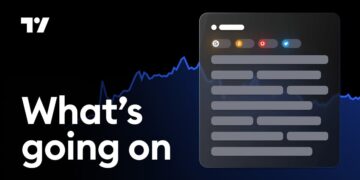NEW YORK, NEW YORK – JULY 29: Baiju Bhatt (right) and Vlad Tenev, founders of the online brokerage … More
New research reveals retail investors spend just six minutes researching stocks before trading, yet their collective behavior is increasingly driving market movements as trading volumes surge and buy-the-dip strategies become more aggressive.
The stereotype of the hurried retail investor making split-second decisions based on little more than a hunch has been confirmed by groundbreaking academic research. A study by Jeffrey Wurgler, Nomura Professor of Finance at NYU Stern, and his colleagues found that the median retail investor spends just six minutes conducting internet-based research before making a stock trade.
This finding takes on new significance as retail investors have become increasingly bold in their market behavior. Recent data from J.P. Morgan shows individual investors net bought a record $4.7 billion worth of equities in a single day during April’s market selloff, the highest daily inflow in a decade. This “buy-the-dip” mentality has strengthened dramatically since 2022, marking a behavioral shift from the panic selling witnessed during the March 2020 market crash.
The influence of individual investors has grown substantially, with retail trading now accounting for roughly 20% of total market volume. This is double the levels seen a decade ago. Trading app downloads surged during the pandemic, with platforms like Robinhood reporting millions of new accounts, while Interactive Brokers recently saw a 44% increase in options orders following market volatility.
Price Charts Trump Fundamentals
Wurgler’s research, which analyzed eight million rows of browser data from individual investors, reveals troubling patterns in how retail traders conduct research. The study found that investors overwhelmingly focus on price charts rather than fundamental analysis, with the most common lookback period being just a single day.
“It caters to the lowest common denominator of research ability,” Wurgler explained in a recent podcast interview. “We understand stocks, we want them to go up. And if we see a picture in which the stock is going up today, well, that’s more satisfying than something that’s flat or something that’s slightly down.”
This focus on short-term price movements is particularly striking given that most investors in the study held their positions for several weeks. The disconnect between research timeframe and holding period suggests a fundamental misalignment in investment approach.
The Yahoo Finance Effect
The research uncovered another significant finding: Yahoo Finance dominates retail investor research, serving as the primary information source for millions of traders. This concentration creates what Wurgler calls a feedback loop, where the information presented on the platform’s default pages drives collective investor behavior.
“By far the most commonly used investment data website is Yahoo Finance,” Wurgler noted. “So depending on what is served to you on Yahoo Finance, that’s served to pretty much everybody, or at least millions of people.”
This phenomenon has profound implications for market dynamics. When millions of investors rely on the same information source and default settings, it can amplify certain market trends and create herd-like behavior.
The study also confirmed what many market observers have long suspected: retail investors are heavily influenced by news events and brand recognition. Major corporate announcements, like Apple’s iPhone launch during the study period, generated massive spikes in investor research activity.
This pattern has only intensified with the rise of social media. While Wurgler’s data predates platforms like Reddit and TikTok, the underlying behavior (following salient news and recognizable brands) remains consistent. The 2021 meme stock phenomenon with GameStop and AMC as well as the meteoric rise of Pump Fun demonstrated how social media can amplify these tendencies.
Professional Money Managers Take Notice
NEW YORK, NEW YORK – MARCH 22: The Gamestop company logo is displayed on a screen as traders work on … More
Perhaps most concerning is what retail investors don’t research: risk statistics, financial fundamentals, and proper diversification metrics. The study found that sophisticated risk measures like beta, cash flow analysis, and balance sheet examination are “almost nonexistent” among individual investor research habits.
“Most people come into an investment with a rough assessment of risk based on how much upside they see in some kind of informal way,” Wurgler observed. This informal approach to risk assessment can lead to poorly diversified portfolios and unexpected losses.
The growing influence of retail trading has forced institutional investors to adapt their strategies. Professional money managers now must consider not just fundamental analysis but also what might capture retail investor attention.
This dynamic echoes John Maynard Keynes’ famous observation about markets being a beauty contest where participants try to predict what others will find attractive. Today’s version involves predicting what will trend on financial social media or appear prominently on retail trading platforms.
From Panic Selling to Aggressive Buying
The evolution of retail investor behavior is perhaps most evident in how they respond to market volatility. During the March 2020 crash, individual investors largely sold off their positions, showing a 75% correlation between their flows and negative market performance. Today’s retail investors display the opposite behavior.
The April 2024 market selloff, triggered by sweeping tariff announcements, saw retail investors split their record $4.7 billion in purchases almost evenly between individual stocks ($2.3 billion) and ETFs ($2.4 billion). Nvidia alone attracted $913 million in net buying, while S&P 500-tracking ETFs received $900 million in inflows.
This shift suggests retail investors have grown more confident in their ability to time market bottoms, despite spending minimal time on research. The combination of quick decision-making and aggressive dip-buying creates a powerful force that can amplify both market recoveries and potential losses.
The Democratization Dilemma
The surge in retail trading represents both opportunity and challenge for market efficiency. On one hand, increased participation democratizes investing and provides more capital to growing companies. On the other hand, the research suggests many retail investors may lack the tools and knowledge for effective investment decision-making. The question for regulators and platform providers is whether to nudge investors toward more comprehensive research or accept that quick, intuitive decisions are simply part of modern market behavior.
Wurgler’s ongoing research aims to determine whether more research actually leads to better investment outcomes. The preliminary indication suggests the relationship may be flat or even negative, potentially because investors who research more also trade more frequently, a pattern associated with underperformance.
As retail trading continues to grow, understanding these behavioral patterns becomes crucial for market stability and investor protection. The six-minute research window may be brief, but its collective impact on markets is anything but small. The rise of retail trading represents a fundamental shift in market dynamics, one where traditional fundamental analysis competes with social media trends and brand recognition for investor attention. For better or worse, the six-minute investor is here to stay.











